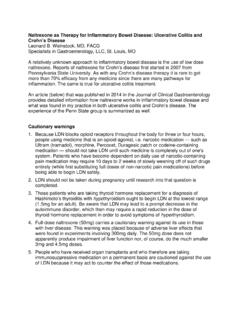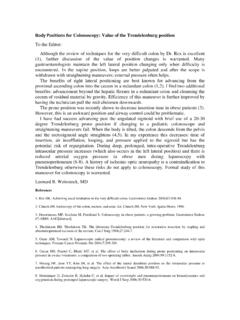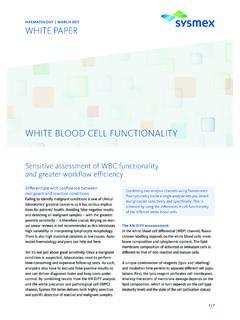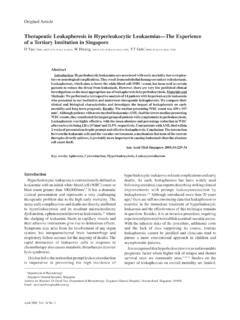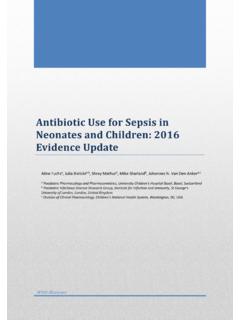Transcription of small intestinal Bacterial overgrowth - gidoctor.net
1 Hospital Physician Board Review Manual flora are defined as natural living organisms with-in the gastrointestinal (GI) tract. The GI tract at birth is sterile, but bacteria in the environment as well as expo-sure to the birth canal, food, and caregivers quickly give rise to the gut flora. Bacteria are the primary organisms, with yeast and helminths added to the milieu depending on geographic region and prior exposures. The bacte-rial population numbers over 100 trillion organisms and is estimated to contain 500 to 1000 species; of these, at least 50% cannot be cultured with current The environment in the mouth and upper gut al-lows aerobic organisms to grow, while anaerobic condi-tions predominate in the distal gut, enhancing coliform Bacterial reproduction. The majority of bacteria form a symbiotic relationship with the host (the good flora ), providing benefits such as development of normal gut immunology and histology, fermentation of indi-gestible polysaccharides, and metabolism of vitamins and drugs.
2 This symbiotic relationship depends on a properly functioning host barrier. However, the host barrier comprises several mechanisms, including lumi-nal mechanisms and digestive enzymes, tight junctions between epithelial cells, and the gut immune system. In addition, epithelial production of alpha defensins and mucin prevent bacteria translocation, and secretory IgA produced by the intestinal mucosa protects against Bacterial invasion. In general, diseases associated with gut flora occur when the defense mechanisms break down and allow for Bacterial overgrowth in the small intestine, when bad bacteria proliferate, or when good bacteria are destroyed by antibiotics. This man-ual discusses commensal bacteria and disorders of the balance in gut flora that lead to harmful outcomes. Ba CT eRI al BalaNC e The GOOD FlORaThe number of bacteria in the human gut exceeds that found in other mammals, but the diversity is less complex.
3 The largest classes are the Firmicutes and The complexity and number of bacteria increases as one goes from the stomach to the colon (Table 1). Relatively few of the dietary and oropharyn-geal organisms that are swallowed survive the acidity of the stomach to enter the duodenum (100/g). In the distal ileum, there is a dramatic increase in the number of bacteria (in the 107 108/g range), with the flora predominantly comprising fecal-like anaerobes. In the right colon, the bacteria count increases 3 log folds, with the same type of organisms but with more Bifidobacteria and Clostridia. Animal studies have demonstrated several benefits of bacteria, including the development of normal immu-nity and gut In the absence of bacteria, mice lack T cells and IgA secretion. Bacteria also play an im-portant role in energy Conventionally raised mice have 40% more total body fat than germ-free mice fed the same diet, as bacteria are responsible for salvag-ing energy from indigestible dietary polysaccharides.
4 Stool contents obtained from normal rats transplanted to the intestine of germ-free rats rapidly increased body fat content by several mechanisms: elevations of serum glucose and insulin stimulating liver fat production; increased availability of short-chain fatty acids (SCFA); and suppression of the lipoprotein lipase also ferment insoluble fiber and nonab-sorbable carbohydrates, including indigestible polysac-charides. Subsequent SCFA provide additional calories as well as important nutrition to the epithelial cells of the SCFA are responsible for regulating cell proliferation and vascular flow within the mucosa. When stool flow is diverted from the colon, the colonic lining may become Bacteria also play an important role in metabolic processes. Clostridium and Escherichia coli hydrolyze con-jugated bile acids, allowing dietary fat and fat-soluble vitamins to be processed and This process is adversely affected by Bacterial overgrowth or imbal-ance (dysbiosis) in the small intestine.
5 Bacteria also metabolize dietary vitamin K from leafy vegetables and convert it to an absorbable K2 form. This process is also dependent on the presence of bile salts and results in improved bioavailability. Drugs and other unnatural GasTRoenTeRoloGy BoaRd Review Manualsmall intestinal Bacterial overgrowth leonard B. weinstock, Gastroenterology Volume 14, Part 2 S m a l l I n t e s t i n a l B a c t e r i a l O v e r g r o w t hcompounds may be metabolized by bacteria in various ways. The inflammatory bowel disease (IBD) drugs su lfasalazine and balsalazide are made bioavailable by Bacterial enzymes. Estrogens are also affected by bacte-rial enzyme movement form and activity are dependent on bacteria, as bacteria account for 50% to 80% of stool weight and bulk. There are 109 to 1011 bacteria per mL of stool. Finally, immune tolerance, defense, and cyto-protection rely on the presence of bacteria in the gut.
6 Early exposure to bacteria such as nonpathologic forms of E. coli allows humans to build up tolerance to patho-genic E. coli. The balance of protective versus harmful enteric bacteria determines whether there is mucosal homeostasis or inflammation. In addition to healthy commensal bacteria, the human gut flora can include small quantities of bad bacteria, noninvasive yeast, and helminths (Table 2). Yeast generally does not play a role in disease below the level of the esophagus and mouth. The variety of flora is partially dependant on the degree to which the society is hygienic. In agrarian cultures, helminth infestation is common, and is most often asymptomatic. Some spe-cific immune benefits from helminths should be noted. Helminths induce mucosal T cells to make regulatory cytokines, including interleukin (IL)-4, transforming growth factor-beta, and Worms also induce various regulatory-type T-cell subsets in the gut that limit effector T-cell growth and impede release of IL-12, interferon- , and tumor necrosis factor-alpha (TNF- ).
7 9al TeReD FlORa aND/OR BalaNCeNormally, the bacteria that may tilt the inflammatory activity into a disease state are kept in check by good flora, immunity, and intestinal integrity. small intestinal dysfunction, mucosal damage, and potential systemic inflammation will occur due to imbalance, especially with overgrowth of coliforms. Altered microecology in combination with phenotypic predisposition may result in various diseases. Genetic alterations decrease immune barriers and affect how bacteria increase proinflammatory immune cells and responsiveness in There is also a higher incidence of a proinflam-matory state in the irritable bowel syndrome (IBS) with decreased IL-10 production and increased TNF- The following are 4 examples where either imbalance or the wrong type of bacteria are Diarrhea Most mild cases of antibiotic-associated diarrhea (AAD) are due to functional disturbances of intestinal carbohydrate or bile acid metabolism, allergic and toxic effects of antibiotics on intestinal mucosa, or pharma-cologic effects on Clostridium difficile accounts for 10% to 20% of all cases of AAD.
8 Other infectious organisms include Clostridium perfringens, Staphylococcus aureus, Klebsiella oxytoca, Candida, and enteroinvasive Bacteria in Crohn s diseaseIncreased harmful bacteria (Bacteroides, invasive E. coli, and enterococci) and decreased levels of beneficial Bacterial species (Bifidobacterium and Lactobacillus) have been suggested to trigger new cases and relapses of A study of adherent-invasive E. coli (AIEC) in 63 patients with Crohn s disease that defined invasion as living or-ganisms in intestinal cells found AIEC in 21% of chronic lesions in Crohn s patients but in only 6% of resected ileum specimens from non-Crohn s ObesityRecognition that certain bacteria may be more ef-ficient in assisting in energy recovery of indigestible foods suggests that an imbalance of these bacteria may Table 1. Dominant Gut Bacteria and Typical Colony Counts Stomach: 0 102 Lactobacillus, Candida, Streptococcus, Helicobacter pylori, PeptostreptococcusDuodenum and jejunum: 102 Streptococcus, LactobacillusProximal ileum: 103 Streptococcus, LactobacillusDistal ileum: 107 108 Clostridium, Bacteroides, coliformsColon: 1011 1012 Bacteroides, Bifidobacterium, Clostridium coccodesm, Clostridium leptum, Fusobacterium Adapted with permission from Sartor BR.
9 Therapeutic manipulation of the enteric microflora in inflammatory bowel diseases: antibiotics, pro-biotics, and prebiotics. Gastroenterology 2004;2004;16:1620 33. [au: Is this adapted from a table in the Sartor article, or is it from the text? If from a table, what page is the table on?]Table 2. Gut Bacteria Categories and CharacteristicsCharacteristicsExamples Good bacteriaProtective, anti-inflammatoryLactobacilli, Bifidobacteria, nonpatho-genic Escherichia coli, Streptococcus thermophilus Bad bacteriaInjurious, proin-flammatoryBacteroides vulgatus, Enterococcus faeca-lis, E. coli enteroinvasive, Klebsiella Ugly bacteriaToxic, invasiveClostridia difficile, Camphylobacter, E. coli, Salmonella, Shigellawill fix BB Hospital Physician Board Review Manual m a l l I n t e s t i n a l B a c t e r i a l O v e r g r o w t hbe a cause of Methane-producing bacteria, especially Methanobrevibacter smithii, lower the partial pressure of hydrogen by utilizing hydrogen and carbon dioxide after degradation of polysaccharides, allowing for further degeneration of polysaccharides and ability to provide more calories.
10 This newly described role of Bacterial flora in the etiology of obesity in man is a con-troversial but exciting Bowel SyndromeFecal DNA testing studies have demonstrated high variation in Bacterial counts from stool from IBS Another study reported less Lactobacillus in IBS-diarrhea (IBS-D) patients versus IBS-constipation (IBS-C) patients and controls and higher concentra-tions of Veillonella in IBS-C patients than in The important role of small intestinal bacteria in IBS will be reviewed later. The UGly FlORaC. difficile commonly colonizes infants without harm, and 4% and 7% of adults carry C. difficile as nonpatho-logic organisms. A recent study suggested that dense colonization of the intestine by enterococci may be associated with C. difficile Only when the balance changes so that normal bacteria are reduced in numbers by antibiotic use do these organisms prolifer-ate and cause disease.
